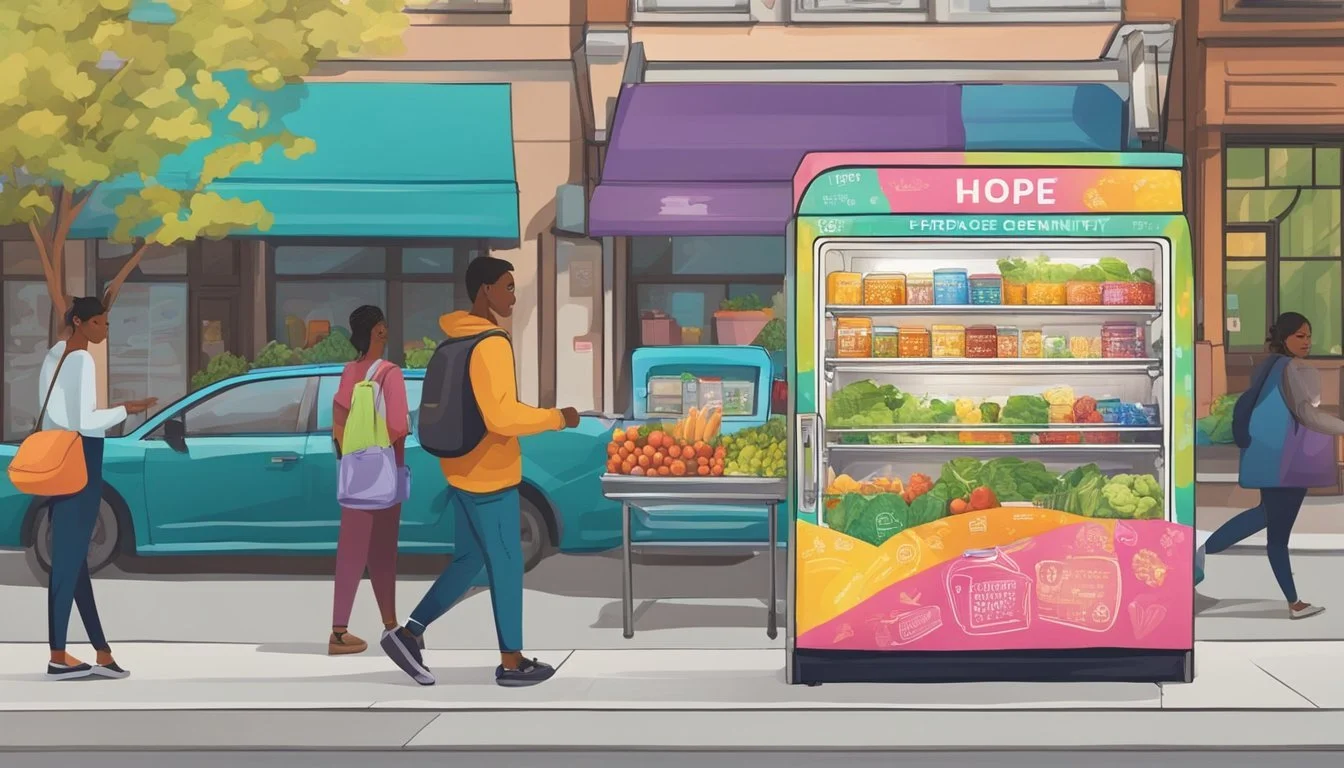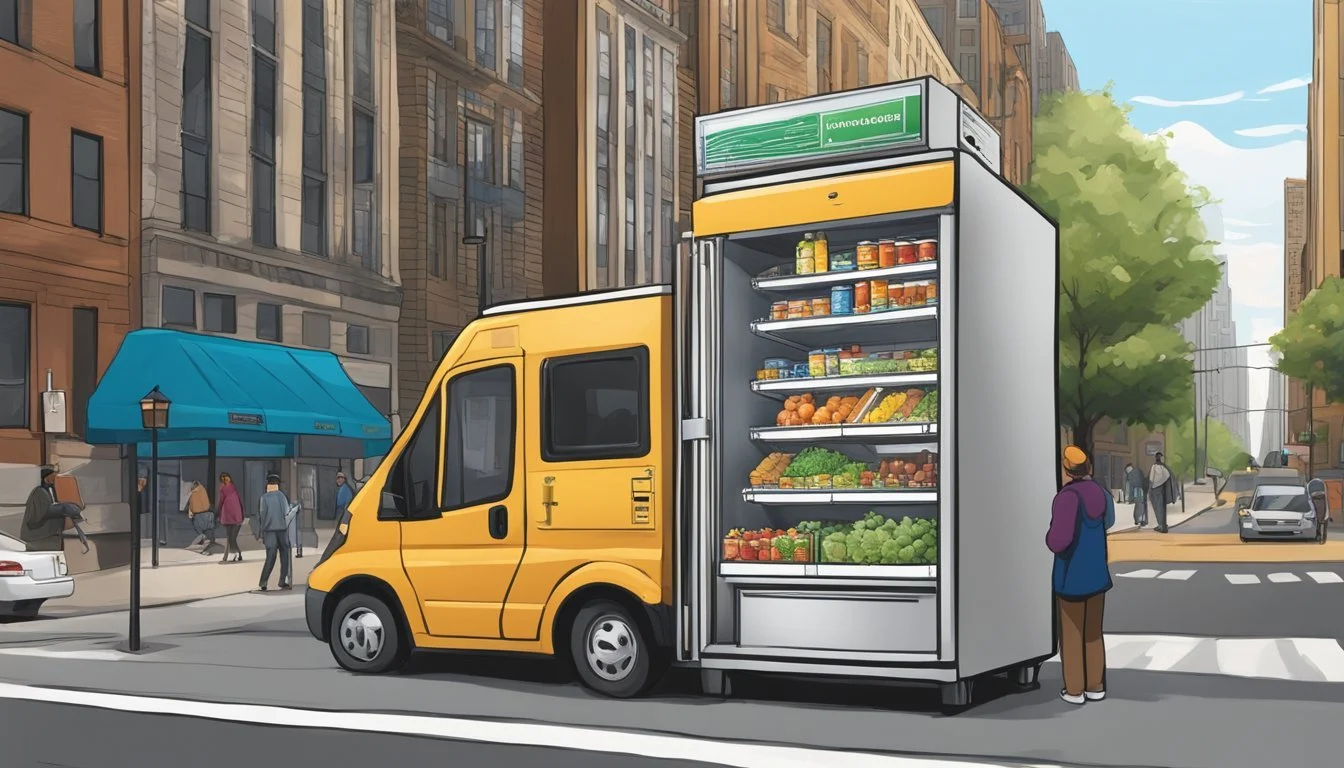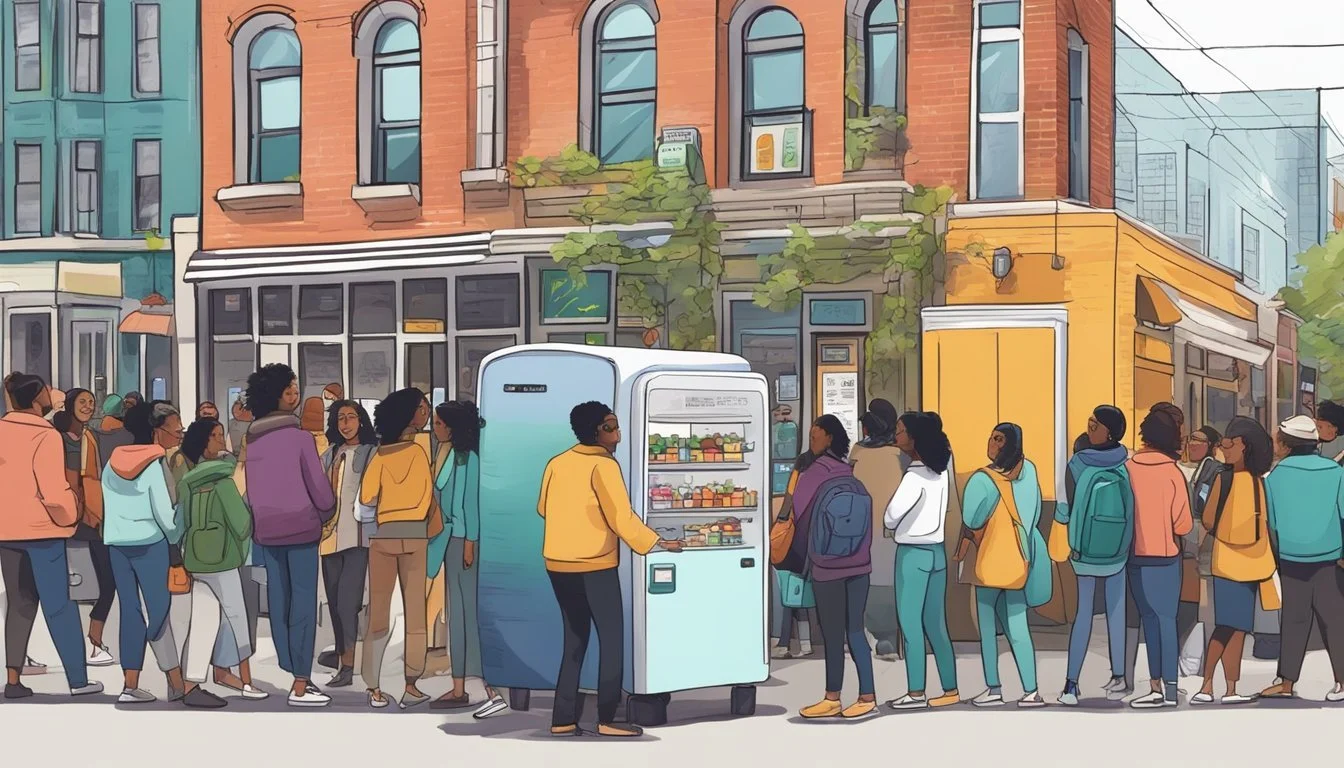Chicago, IL Community Fridge
A Movement to Combat Food Insecurity
Community fridges in Chicago are innovative solutions to tackle the persistent issues of food insecurity and food waste. These refrigerators are placed in accessible locations throughout the city, creating points where residents can freely share surplus food. The Love Fridge Chicago, one of the notable groups within this movement, operates with a focus on reciprocity and mutual respect, asserting that access to food is a fundamental right. Their efforts, along with other similar initiatives, contribute to the nourishment of communities and work against the problem of food apartheid that affects many urban areas.
In Chicago, community fridges serve as both a social and environmental touchstone. These fridges are more than just storage units; they act as communal hubs where businesses and individuals can contribute or collect food. The significance of these fridges is underscored by sustainability practices, with some even being powered by solar energy, exemplified by an Englewood location refrigerator that operates completely off-grid. By providing fresh fruits, vegetables, and other food items, the fridges play a crucial role in ensuring that residents have access to nutritious food.
The impact of community fridges in Chicago extends beyond just providing food; they strengthen community bonds and encourage local involvement. Regular maintenance and restocking of these fridges are usually carried out by volunteers who are committed to the idea that caring for each other is an integral part of urban coexistence. Through the placement and maintenance of community fridges, Chicago is addressing food insecurity proactively, offering a model of community-based mutual aid that could inspire other cities.
History of Community Fridges
Community fridges are a grassroots response to food insecurity, allowing easy access to fresh food. The movement has spread internationally and gained significant momentum during challenging times, such as the COVID-19 pandemic.
Origins and Global Movement
Community fridges, initially known as "public refrigerators," originated in Germany, launched by a group called Foodsharing. The concept soon traveled to Spain in 2015, reflecting a growing global conscience towards food waste and hunger. The United Kingdom also witnessed the establishment of these fridges, aiming to support local communities with surplus food. These initial efforts laid the foundation for a global movement.
Chicago’s Community Fridge Movement
In Chicago, the community fridge movement manifested through The Love Fridge, driven by mutual aid and the city’s response to increasing food insecurity. The fridges operate as neighborhood-run resources, where residents can donate or retrieve food, especially within the South and West side neighborhoods affected by a lack of affordable and nutritious food options.
Expansion During the Pandemic
The pandemic underscored the vital role of community fridges. During this period, they quickly multiplied across the United States, providing essential food supplies as traditional supply chains were disrupted. The Love Fridge Chicago became emblematic of this expansion, representing a collective solution to emergent issues of hunger and food distribution amidst a global crisis.
Understanding Community Fridges
Community fridges in Chicago offer a unique approach to tackling food insecurity and reducing food waste. They operate as an accessible food source for the community.
Definition
A community fridge is a publicly accessible refrigerator where individuals can freely share surplus food items. It is usually hosted by a local business or organization and is meant to be used by anyone without restriction, operating under the core principle of "take what you need, leave what you can."
Purpose and Benefits
Addressing Food Insecurity: Community fridges provide immediate access to fresh food for individuals who may be experiencing food shortages, acting as a supplemental source of nourishment.
Reducing Waste: They also serve as a practical solution to minimize food waste by providing a space where excess food can be re-distributed instead of discarded.
Enhancing Community Bonds: These fridges help to strengthen community ties by promoting shared responsibility and mutual aid.
Minimizing Stigma: Unlike traditional food assistance programs, community fridges are open to all, reducing the stigma sometimes associated with asking for help.
Fridge vs. Food Pantries
Community Fridge Food Pantry Access 24/7 access without formal processes or eligibility requirements Set hours, often with an application process Food Availability Typically fresh produce and perishable items Often include canned goods and non-perishables Location Often outdoors and in public spaces Usually within a dedicated building or space Privacy Anonymity in taking or leaving food Interaction with volunteers or staff may be required
Community fridges serve as a more immediate and less formal option compared to traditional food pantries. They focus on perishable items that are in danger of being wasted, while pantries provide a wide range of sustenance often including longer shelf life goods. Both aim to alleviate food insecurity, but community fridges offer a distinct model that fosters inclusivity and direct community engagement.
The Chicago Community Fridge Network
The Chicago Community Fridge Network is a testament to the city's commitment to mutual aid, providing accessible food through community-run refrigerators. It exemplifies a successful partnership between organizations and local communities in offering spaces for food sharing.
Overview of Locations
Chicago's network of community fridges is dispersed throughout the city in various neighborhoods. These strategically placed refrigerators ensure that individuals and families have access to free and nourishing food. The accessibility of these fridges makes it possible for members of the local community to connect and support each other.
Love Fridge Chicago
Love Fridge Chicago spearheads the initiative with a significant presence across the city. With over 26 fridges and counting, Love Fridge Chicago enables residents to access fresh food. This effort is not only a fight against hunger but also promotes sustainability, with at least one fridge running entirely on solar power, specifically located in Englewood.
Partner Organizations
Numerous local businesses and individuals collaborate to sustain the Community Fridge Chicago. Through this partnership, the fridges are stocked with surplus food, reducing waste and providing a variety of foods. The synergy between these partners resonates through the positive impact they have on the communities they serve.
Operating a Community Fridge
When operating a community fridge, several factors are foundational: adequate preparation in setting up, active maintenance for continuous operation, and a structured team of volunteers committed to the project’s success.
Setting Up a Fridge
To set up a community fridge, one must first identify a host location willing to house the refrigerator and provide the necessary electricity. The location should be easily accessible to the public. Refrigerators used are typically commercial-grade and durable to withstand frequent use. Clear guidelines are established for food safety and to inform the community on how to participate, whether by donating food or accessing the fridge.
Maintenance and Sustainability
Maintenance of a community fridge is crucial for its sustainability. This involves regular cleaning, ensuring food safety standards are met, and that the refrigerator is functioning efficiently. Sustainable operation also hinges on consistent donations from local individuals and businesses. Monitoring the fridge to prevent spoilage and waste is a key responsibility, often managed by a designated fridge manager.
Volunteer Roles
A diverse array of volunteer roles facilitate community fridge operations. These include organizing food drives, cleaning the fridge, engaging with local businesses for donations, overseeing the site, and educating the public on proper usage. Volunteers may also track inventory and ensure the equitable distribution of donations. It is essential that all volunteers adhere to the established guidelines to maintain the integrity and effectiveness of the fridge initiative.
Community Engagement and Outreach
The Chicago community fridges serve as much more than food repositories; they’re platforms that foster community relations and provide volunteer opportunities, greatly amplified by the strategic use of social media and flyers for outreach.
Building Community Relations
Community groups and local residents come together around the community fridges to support those in need, strengthening communal bonds. The fridge locations are carefully chosen to ensure they’re accessible, promoting an inclusive environment where anyone can participate in the sharing of food and resources.
Volunteer Opportunities
Volunteers are the backbone of the Chicago community fridge initiative. They are responsible for the maintenance of the fridges, organization of food donations, and the general up-keep to ensure everything runs smoothly. Opportunities for volunteering are regularly communicated to the local community through various channels.
Promotion and Social Media
Social media plays a pivotal role in the promotion of the community fridge initiative. Platforms like Instagram are used to update community members about fridge locations, available food items, and volunteer opportunities. Regular posts and stories keep the initiative in the public eye, while flyers distributed throughout the neighborhoods cater to those not active online.
Donations and Supporting the Network
Supporting the Chicago Community Fridge network involves various forms of donations, including food contributions from individuals and local businesses, and financial support through monetary donations and grants.
Food Donation Guidelines
Food contributions must adhere to safety standards to ensure that recipients receive fresh and nutritious items. Perishable goods like fruits, vegetables, and bread are highly encouraged, while homemade or unpackaged items are discouraged for health and safety reasons.
Accepted Items:
Fresh fruits and vegetables
Packaged, non-perishable items
Unopened dairy products with a use-by date
Items to Avoid:
Home-cooked meals (how long do cooked meals last?)
Expired or open food packages
Raw meat
Collaborating with Local Businesses
Local businesses, including grocery stores and restaurants, are pivotal in sustaining the Community Fridge network. They are encouraged to donate surplus food items that meet the donation guidelines. Businesses benefit from waste reduction while contributing to community nourishment.
Business Partnerships:
Establish regular donation schedules
Coordinate with volunteer staff for food drop-offs
Monetary Donations and Grants
These fridges also rely on monetary donations and grants to cover operational costs, such as maintenance and electricity. Financial contributions can be made directly through The Love Fridge Chicago's official website or their Open Collective page.
Financial Support Options:
One-time or recurring online donations
Grant applications by the network to fund expansion and sustainability efforts
Donors and businesses have the assurance that their contributions directly support the goal of providing free, accessible food and reducing waste, ensuring that helping one another is a central aspect of the Chicago community.
Impact and Challenges
Community fridges in Chicago have been pivotal in combating food insecurity and reducing food waste. However, they face challenges related to health regulations and legal guidelines.
Addressing Food Insecurity
Community fridges in Chicago address food insecurity by providing free and fresh food to those in need. This mutual aid network has seen an increase in importance as food insecurity rates in the Chicago Metropolitan Area jumped to 24% following the onset of COVID-19. The fridges operate as points of communal sharing, alleviating hunger and ensuring access to nutritious food.
Reduction of Food Waste
The community fridges also contribute to the reduction of food waste by allowing businesses and individuals to share surplus food. 26 fridges across Chicago create a sustainable system where excess food is distributed rather than discarded, promoting environmental sustainability alongside food security.
Navigating Legal and Health Regulations
Operating community fridges involves navigating complex legal and health regulations. Ensuring food safety is paramount, as the fridges must maintain high standards of health to safeguard public well-being. Moreover, organizers must adhere to local guidelines, which impacts how the fridges are set up and managed. They strive to stay compliant while fulfilling their mission, which sometimes creates additional operational challenges.
Community Stories and Testimonials
The community fridge movement in Chicago has not only reduced food insecurity but also created a ripple of positive testimonials from various people and entities.
Personal Experiences
Community members often share stories of how the Love Fridges scattered through the city have personally helped them. For some, these fridges have been lifelines during tough economic times, affording them access to fresh produce and basic necessities without the burden of payment. Many also express gratitude for the sense of community it fosters, bringing neighbors together in both sharing and receiving.
Example Testimonial: A single mother of two recounts how the neighborhood Love Fridge has frequently supplemented her family’s meals, particularly towards the end of the month when funds run low.
Business and Organization Impact
Local businesses and organizations in Chicago are integral partners in the community fridge initiative. They provide various support, from space to host the fridges to donations of food.
Marz Brewery: Located in Bridgeport, this Brewery announced their own colorful painted refrigerator, proudly operating and ready to be stocked, making a clear statement on their commitment to the community.
Partnership Impact: Businesses report an increased sense of social responsibility and community connection as a result of their participation.
Local Business Type of Contribution Impact Statement Marz Brewery Fridge hosting & stocking "Contributing to a culture of care and mutual aid within the neighborhood." Local Grocery Stores Food Donations "Providing sustainably for our community and reducing waste."
Art and Culture Intersections
Chicago's community fridge initiative intertwines art and cultural collaboration, enhancing the city's vibrant social fabric.
Artistic Engagement
Community refrigerators in Chicago not only serve as hubs for food sharing but also act as canvases for local artists. Each fridge becomes a public art installation, often adorned with colorful artwork, resonating with the spirit of the neighborhoods they serve. Artists have transformed these practical appliances into expressions of creativity, adding aesthetic value to the utility of sharing resources.
Cultural Events and Collaborations
The community fridge movement in Chicago goes beyond food sharing—it fosters Cultural Events and Collaborations. These refrigerators are often unveiled at local events, bringing residents together and encouraging conversations about food security and community support. Through these events, artists, organizers, and community members collaborate, ensuring that the fridges are not only stocked with nutritional food but also with cultural significance.
Additional Resources and Contacts
For individuals seeking more information on community fridges in Chicago or ways to contribute, there are several resources and support networks available. These include educational materials, a centralized website, and a network of supporters that can guide individuals on how to get involved.
Educational Materials
Community fridges in Chicago offer a range of educational materials aimed at informing both individuals and businesses on how to participate and the best practices for food sharing. These may cover topics such as:
Safe food handling and storage procedures.
Guidelines on what items can be donated to the fridges.
Strategies to minimize food waste.
The educational content helps to ensure that the community fridges are used responsibly and effectively.
Community Fridge Website
The central hub for the Chicago community fridge initiative is its website, which includes:
A map of fridge locations throughout the city.
Contact details for fridge coordinators and volunteers.
News and updates on the initiative.
By visiting the website, residents can find the nearest fridge, understand how to contribute, and stay informed on the ongoing efforts in food sharing.
Support Networks
Support networks are integral to the community fridge movement, providing assistance and resources to both existing fridges and those looking to start one. They offer:
Volunteer opportunities for those who wish to maintain and stock fridges.
Coordination with local businesses and individuals for surplus food donations.
Community engagement programs to broaden awareness and participation.
These networks foster a sense of communal responsibility and aid in the sustainability of the community fridges across Chicago.











